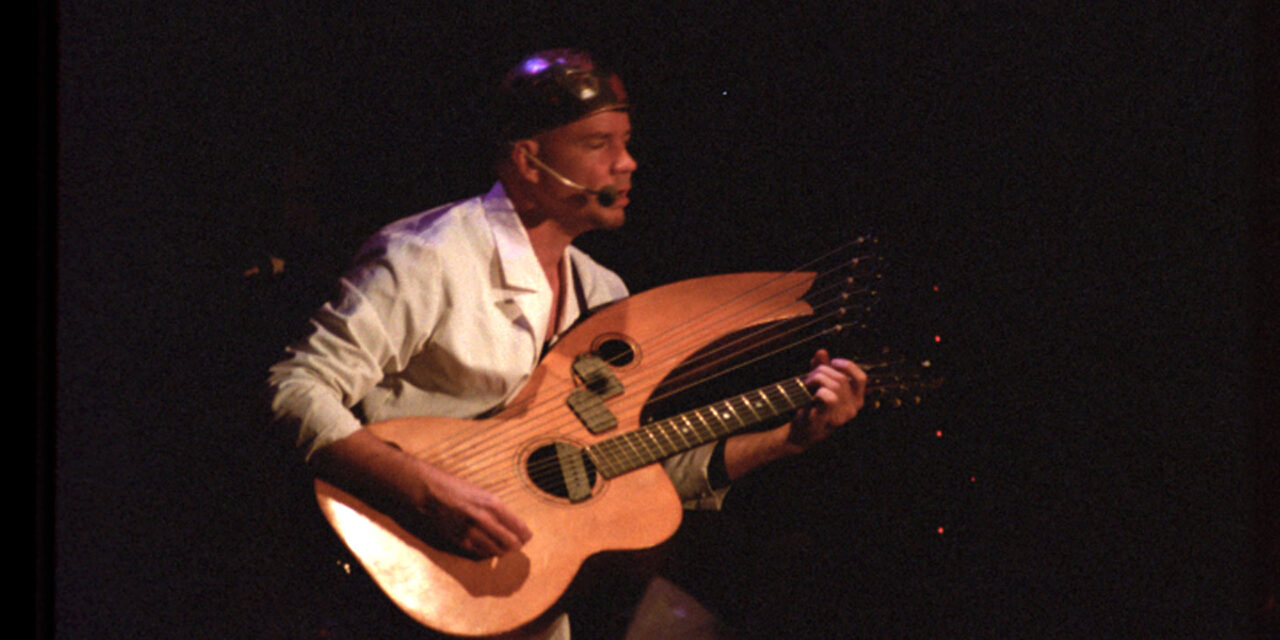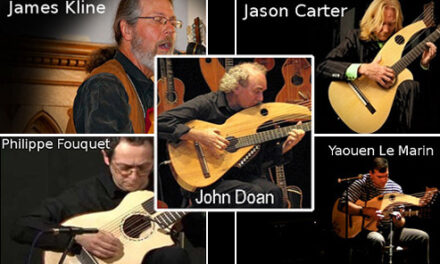
Before and After (or in-between!)
Right photograph courtesy of Jake White
Hedges fans may know the story…for many years, just a rumor, actually. Though I addressed it somewhat on this site, I never discovered the actual details of the how and why. So, in our discussion of harp guitars and Hedges, biographer Jake White committed himself to tracking all that down once and for all. He even got us our first photo of the Dyer in question in situ. Correct – not the Guitar World poster (above) that I included in my own Hedges piece, with its five subs, but the instrument today and an image of Hedges playing the same original instrument on stage with its added/re-installed(-ish) sixth sub-bass string.
Jake kindly wrote today’s guest blog, so that we could have it straight from the horse’s mouth. And so:
When Michael Hedges added a Sixth String to His Dyer Harp Guitar
By Jake White,
Michael Hedges’ Biographer
Michael Hedges was a significant figure in the modern revival of the harp guitar. He brought new techniques and compositional approaches to the instrument when he picked it up in 1984. Learning his piece “Because It’s There” has become a rite of passage for many harp guitarists. Hedges’ first harp guitar was a Dyer with five sub-bass strings. Most readers of this blog know this from studying Hedges’ harp guitar performances on YouTube. But it is a little-known fact that his Dyer was actually originally built for six sub-bass strings. The sixth string was only added when the music called for it during his final tour.
After using several other harp guitars (see Michael Hedges and the Harp Guitar), Hedges returned to his original Dyer instrument during his fall 1997 tour. From 1995-1997, Hedges started writing and performing vocal songs and cover tunes on the harp guitar, often using a pick (plectrum). Before this, he had mostly performed solo pieces on the instrument (using tapping and fingerstyle).
During the last couple weeks of his final tour in November 1997, Hedges arranged and performed a passionate version of Pink Floyd’s “Comfortably Numb.” To make this song work on his harp guitar, he needed six sub-bass strings instead of five. Typically, his instrument had five sub-bass strings, but fortunately, his Dye had been built for six. Hedges’ tour manager Tom Larson explained, “For that tune, he had to wire up a sixth [sub-bass] string. He had gotten an extra tuning machine from Steinberger that he liked, and he put it on. At the intermission, he would have the monitor tech undo that string so it wouldn’t goof him up in the next set when he had to play ‘Because It’s There’” (source: Interview with the author).

Michael Hedges with the 6-bass Dyer in 1997
Photo copyright and courtesy Karen Haskell
Hedges pushed the boundaries of the harp guitar—not just by adding an extra string (mid-show) to make a cover tune work, but with his compositional acumen, string control/stopping, expanded techniques, and creative arrangements. Some may be surprised to learn that Hedges wrote, recorded, or performed at least seventeen pieces on the harp guitar during his career. He has inspired so many of us to pick up the harp guitar and explore new possibilities.
—
For information about the forthcoming Michael Hedges biography, please visit: https://dreamoutloudbook.com/
To learn more about the forthcoming documentary film about Hedges, see: https://michaelhedges.com/documentary/






Thanks for the Dyer enlightenment!! You ever informing dynamo!
The Old Man